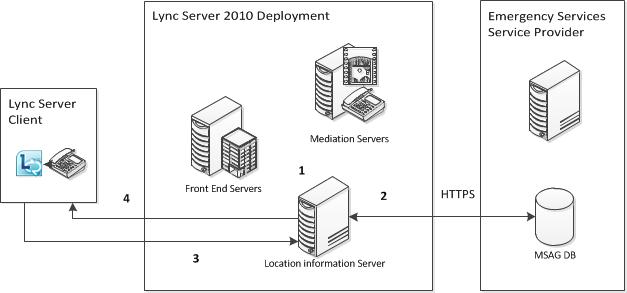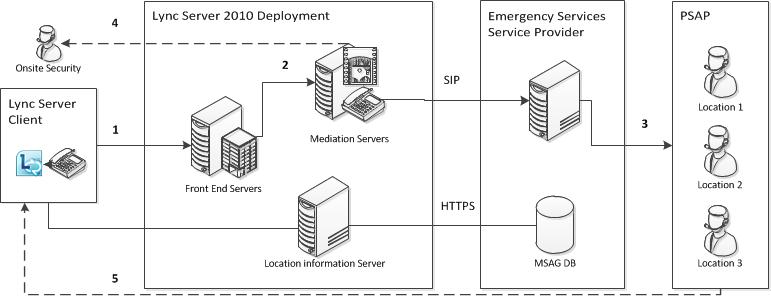Topic Last Modified: 2010-11-05
In order to support Enhanced 9-1-1 (E9-1-1), Microsoft Lync Server 2010 can be configured to include location information with each emergency call originating from an E9-1-1 enabled Lync Server 2010 client. When a user places an emergency call, Lync Server routes the call along with location and callback information through the Mediation Server to an Emergency Services Service Provider. The Emergency Services Service Provider then routes the call to the correct Public Safety Answering Point (PSAP) based on the location information contained within the call.
The Emergency Services Service Provider ensures that no matter where a client is located, the emergency call will be routed to the PSAP that serves to the location of the client. For example, if the main office is located in Redmond, but the user places an emergency call from a branch office in Wichita, the Emergency Services Service Provider will route the call to the PSAP in Wichita, not Redmond.
 E9-1-1 Support in Lync
Server
E9-1-1 Support in Lync
Server
In a Lync Server E9-1-1 deployment the client actively acquires its own location. After registration, the client includes all of the network connectivity information that it knows about itself it in a location request to the Location Information Server. The Location Information Server then uses this information to query the published locations for a location. If there is a match, the Location Information Server returns a location to the client. If there is not a match, the user may be prompted to enter a location manually (depending on Location Policy settings). The location is then included as part of an emergency call, and used by the Emergency Services Service Provider to route the call to the correct PSAP.
This approach can be broken up into two separate processes:
- Acquiring a location
- Routing an emergency call to the Emergency Services Service
Provider
 Note: Note: |
|---|
| Analog devices do not receive location information from the Location Information Server or transmit location with emergency calls to the Emergency Services provider. In order to support E9-1-1 on analog devices, you must provision the analog device’s location information directly with the PS-ALI service provider. The location must be updated with the service provider each time the phone is moved. |
Acquiring a location
The following diagram shows how the client acquires a location.

- The administrator populates the Location database with the
network wiremap.
- The administrator validates addresses with the Emergency
Services Service Provider.
- The client sends a location request, containing network
elements, to the Location Information Server.
- The Location Information Server queries the published locations
for a location and, if a match is found, returns the information to
the client.
Routing an emergency call to the Emergency Services Service Provider
The following diagram shows how an emergency call is routed from Lync Server to the PSAP.

When an emergency call is placed from a compatible Lync Server client:
- An Invite is routed to Lync Server containing the location and
the callback number.
- Lync Server matches the emergency header, and routes the call,
based on the PSTN Usage value defined in the location policy,
through the Mediation Server to the Emergency Services Service
Provider using a SIP Trunk.
- The Emergency Services Service Provider routes the emergency
call to the correct PSAP based on the location that is associated
with the call.
- If configured, Security is sent an IM notification.
- If configured, and supported by the Emergency Services Service
Provider, Security is conferenced into the call.
- If necessary, the PSAP uses the callback number to contact the
client directly.
When the client includes a validated address with the emergency call, the provider immediately directs the call to the PSAP. If the included address was manually entered by the user, the provider first verifies the accuracy of the location with the caller before routing the emergency call to the PSAP.

